ESP MITSUBISHI COLT 2008 Owner's Manual (in English)
[x] Cancel search | Manufacturer: MITSUBISHI, Model Year: 2008, Model line: COLT, Model: MITSUBISHI COLT 2008Pages: 450, PDF Size: 14.57 MB
Page 2 of 450
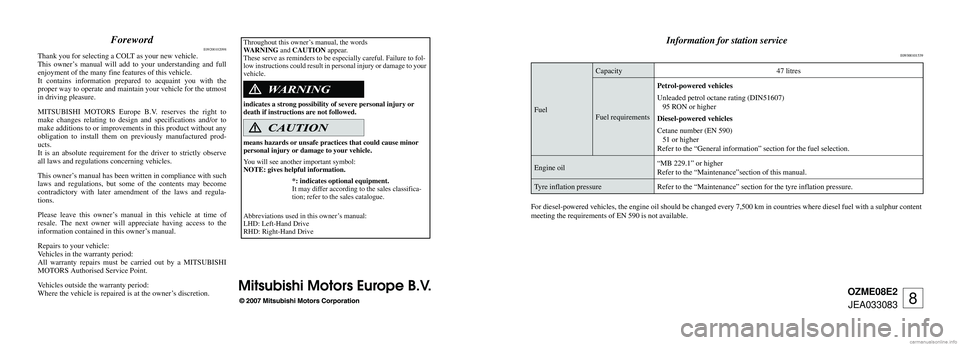
OZME08E2JEA033083
Information for station service
E09300101539
Fuel Capacity
47 litres
Fuel requirements Petrol-powered vehicles
Unleaded petrol octane rating (DIN51607)
95 RON or higher
Diesel-powered vehicles
Cetane number (EN 590)
51 or higher
Refer to the “General information” section for the fuel selection.\
Engine oil “MB 229.1” or higher
Refer to the “Maintenance”section of this manual.
Tyre inflation pressure Refer to the “Maintenance” section for the tyre inflation pressure\
.
For diesel-powered vehicles, the engine oil should be changed every 7,500 km in countries where diesel fuel with a sulphur content
meeting the requirements of EN 590 is not available.
8
Foreword
E09200102098
Thank you for selecting a COLT as your new vehicle.
This owner’s manual will add to your understanding and full
enjoyment of the many fine features of this vehicle.
It contains information prepared to acquaint you with the
proper way to operate and maintain your vehicle for the utmost
in driving pleasure.
MITSUBISHI MOTORS Europe B.V. reserves the right to
make changes relating to design and specifications and/or to
make additions to or improvements in this product without any
obligation to install them on previously manufactured prod-
ucts.
It is an absolute requirement for the driver to strictly observe
all laws and regulations concerning vehicles.
This owner’s manual has been written in compliance with such
laws and regulations, but some of the contents may become
contradictory with later amendment of the laws and regula-
tions.
Please leave this owner’s manual in this vehicle at time of
resale. The next owner will appreciate having access to the
information contained in this owner’s manual.
Repairs to your vehicle:
Vehicles in the warranty period:
All warranty repairs must be carried out by a MITSUBISHI
MOTORS Authorised Service Point.
Vehicles outside the warranty period:
Where the vehicle is repaired is at the owner’s discretion.
Throughout this owner’s manual, the words
WARNING and CAUTION appear.
These serve as reminders to be especially careful. Failure to fol-
low instructions could result in personal injury or damage to your
vehicle.
indicates a strong possibility of severe personal injury or
death if instructions are not followed.
means hazards or unsafe practices that could cause minor
personal injury or damage to your vehicle.
You will see another important symbol:
NOTE: gives helpful information.
*: indicates optional equipment.
It may differ according to the sales classifica-
tion; refer to the sales catalogue.
Abbreviations used in this owner’s manual:
LHD: Left-Hand Drive
RHD: Right-Hand Drive
Page 26 of 450
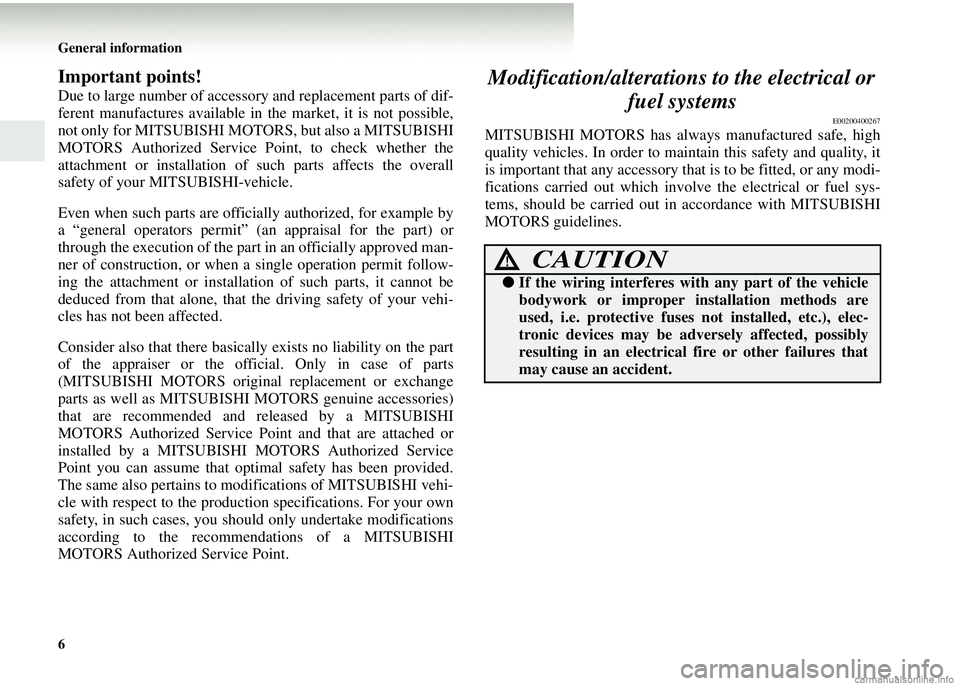
6 General information
Important points!
Due to large number of accessory and replacement parts of dif-
ferent manufactures available in the market, it is not possible,
not only for MITSUBISHI MOTO RS, but also a MITSUBISHI
MOTORS Authorized Service Po int, to check whether the
attachment or installation of such parts affects the overall
safety of your MITSUBISHI-vehicle.
Even when such parts are offici ally authorized, for example by
a “general operators permit” (an appraisal for the part) or
through the execution of the part in an officially approved man-
ner of construction, or when a single operation permit follow-
ing the attachment or installatio n of such parts, it cannot be
deduced from that alone, that the driving safety of your vehi-
cles has not been affected.
Consider also that there basically exists no liability on the part
of the appraiser or the official. Only in case of parts
(MITSUBISHI MOTORS origin al replacement or exchange
parts as well as MITSUBISHI MOTORS genuine accessories)
that are recommended and released by a MITSUBISHI
MOTORS Authorized Service Po int and that are attached or
installed by a MITSUBISHI MOTORS Authorized Service
Point you can assume that optimal safety has been provided.
The same also pertains to modi fications of MITSUBISHI vehi-
cle with respect to the produc tion specifications. For your own
safety, in such cases, you should only undertake modifications
according to the recommen dations of a MITSUBISHI
MOTORS Authorized Service Point.
Modification/alterations to the electrical or
fuel systems
E00200400267
MITSUBISHI MOTORS has always manufactured safe, high
quality vehicles. In order to maintain this safety and quality, it
is important that any accessory that is to be fitted, or any modi-
fications carried out which invo lve the electrical or fuel sys-
tems, should be carried out in accordance with MITSUBISHI
MOTORS guidelines.
CAUTION!
● If the wiring interferes wi th any part of the vehicle
bodywork or improper installation methods are
used, i.e. protective fuses not installed, etc.), elec-
tronic devices may be ad versely affected, possibly
resulting in an electrical fire or other failures that
may cause an accident.
Page 41 of 450
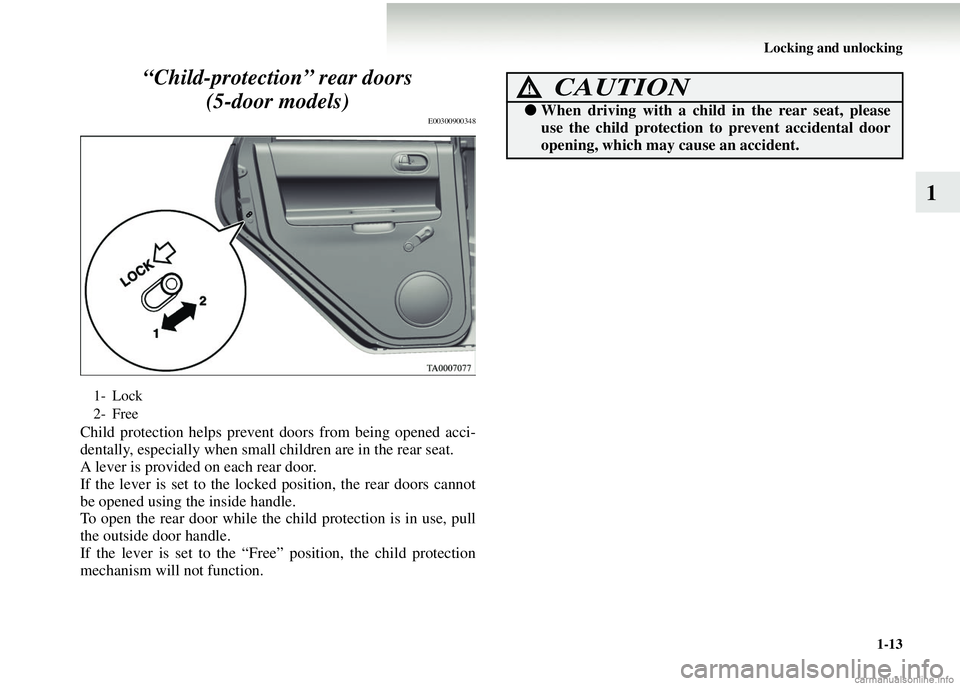
Locking and unlocking1-13
1
“Child-protection” rear doors
(5-door models)
E00300900348
Child protection helps prevent doors from being opened acci-
dentally, especially when small children are in the rear seat.
A lever is provided on each rear door.
If the lever is set to the locked position, the rear doors cannot
be opened using the inside handle.
To open the rear door while the child protection is in use, pull
the outside door handle.
If the lever is set to the “Free” position, the child protection
mechanism will not function.
1- Lock
2- Free
CAUTION!
● When driving with a child in the rear seat, please
use the child protection to prevent accidental door
opening, which may cause an accident.
Page 46 of 450
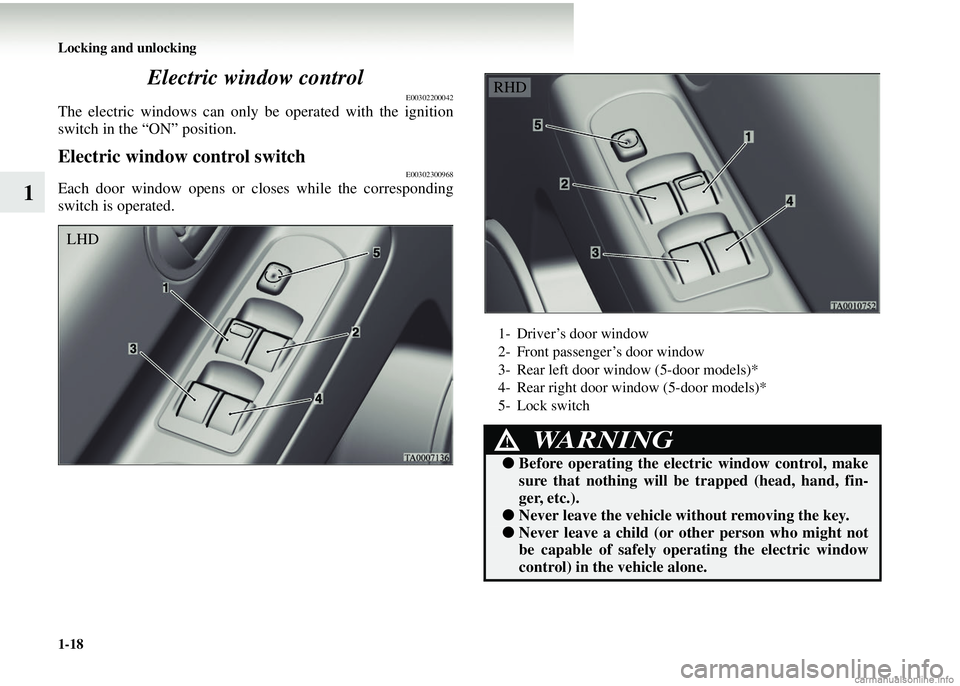
1-18 Locking and unlocking
1Electric window control
E00302200042
The electric windows can only be operated with the ignition
switch in the “ON” position.
Electric window control switchE00302300968
Each door window opens or
closes while the corresponding
switch is operated.
LHD
1- Driver’s door window
2- Front passenger’s door window
3- Rear left door window (5-door models)*
4- Rear right door window (5-door models)*
5- Lock switch
WARNING!
● Before operating the elect ric window control, make
sure that nothing will be trapped (head, hand, fin-
ger, etc.).
● Never leave the vehicle without removing the key.
●Never leave a child (or ot her person who might not
be capable of safely op erating the electric window
control) in the vehicle alone.
RHD
Page 60 of 450
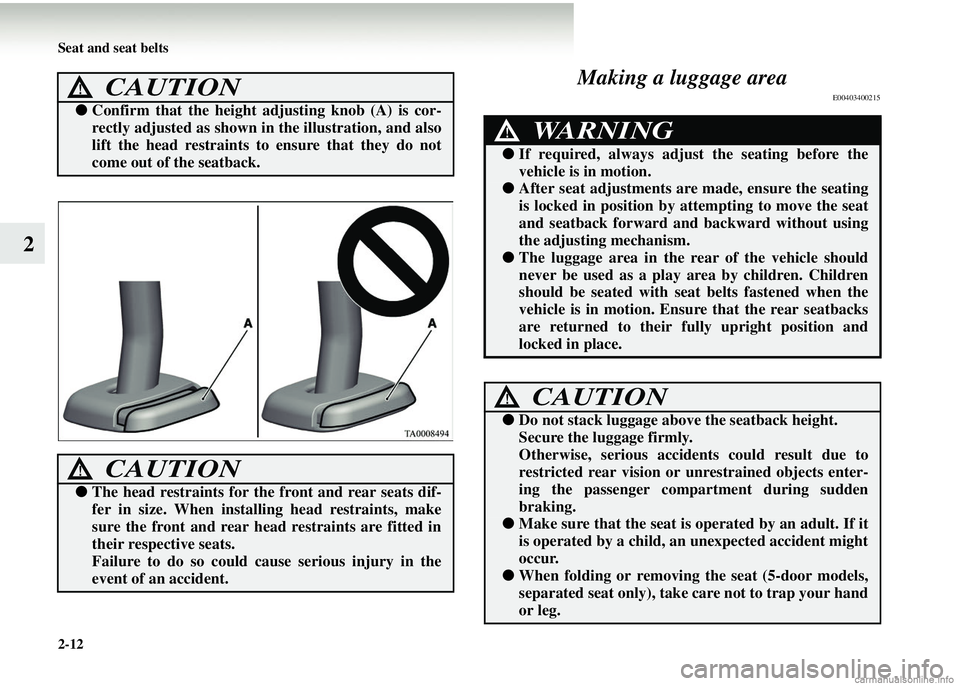
2-12 Seat and seat belts
2Making a luggage area
E00403400215CAUTION!
●
Confirm that the height adjusting knob (A) is cor-
rectly adjusted as shown in the illustration, and also
lift the head restraints to ensure that they do not
come out of the seatback.
CAUTION!
● The head restraints for the front and rear seats dif-
fer in size. When installi ng head restraints, make
sure the front and rear head restraints are fitted in
their respective seats.
Failure to do so could cause serious injury in the
event of an accident.
WARNING!
● If required, always adjust the seating before the
vehicle is in motion.
● After seat adjustments are made, ensure the seating
is locked in position by attempting to move the seat
and seatback forward and backward without using
the adjusting mechanism.
● The luggage area in the re ar of the vehicle should
never be used as a play area by children. Children
should be seated with seat belts fastened when the
vehicle is in motion. Ensure that the rear seatbacks
are returned to their fully upright position and
locked in place.
CAUTION!
● Do not stack luggage above the seatback height.
Secure the luggage firmly.
Otherwise, serious accide nts could result due to
restricted rear vision or unrestrained objects enter-
ing the passenger comp artment during sudden
braking.
● Make sure that the seat is operated by an adult. If it
is operated by a child, an unexpected accident might
occur.
● When folding or removing the seat (5-door models,
separated seat only), take care not to trap your hand
or leg.
Page 70 of 450
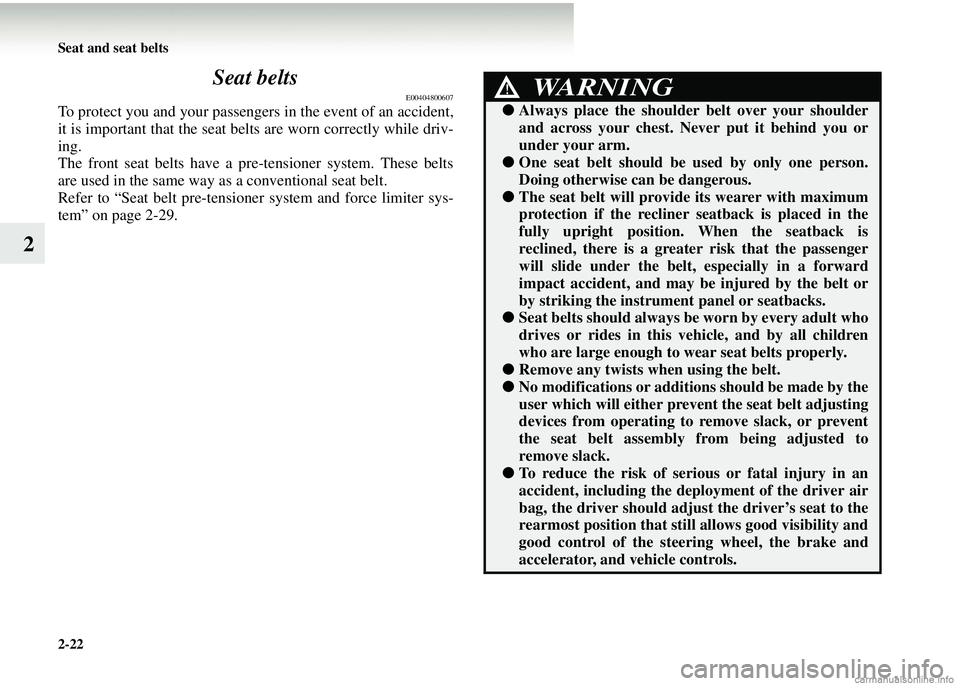
2-22 Seat and seat belts
2Seat belts
E00404800607
To protect you and your passengers
in the event of an accident,
it is important that the seat belts are worn correctly while driv-
ing.
The front seat belts have a pre-tensioner system. These belts
are used in the same way as a conventional seat belt.
Refer to “Seat belt pre-tensioner system and force limiter sys-
tem” on page 2-29.
WARNING!
● Always place the should er belt over your shoulder
and across your chest. Never put it behind you or
under your arm.
● One seat belt should be used by only one person.
Doing otherwise can be dangerous.
●The seat belt will provid e its wearer with maximum
protection if the recliner seatback is placed in the
fully upright position. When the seatback is
reclined, there is a greater risk that the passenger
will slide under the belt, especially in a forward
impact accident, and may be injured by the belt or
by striking the instrument panel or seatbacks.
● Seat belts should always be worn by every adult who
drives or rides in this ve hicle, and by all children
who are large enough to wear seat belts properly.
● Remove any twists when using the belt.
●No modifications or additions should be made by the
user which will either prevent the seat belt adjusting
devices from operating to remove slack, or prevent
the seat belt assembly from being adjusted to
remove slack.
●To reduce the risk of seri ous or fatal injury in an
accident, including the depl oyment of the driver air
bag, the driver should adjust the driver’s seat to the
rearmost position that still allows good visibility and
good control of the steeri ng wheel, the brake and
accelerator, and vehicle controls.
Page 77 of 450
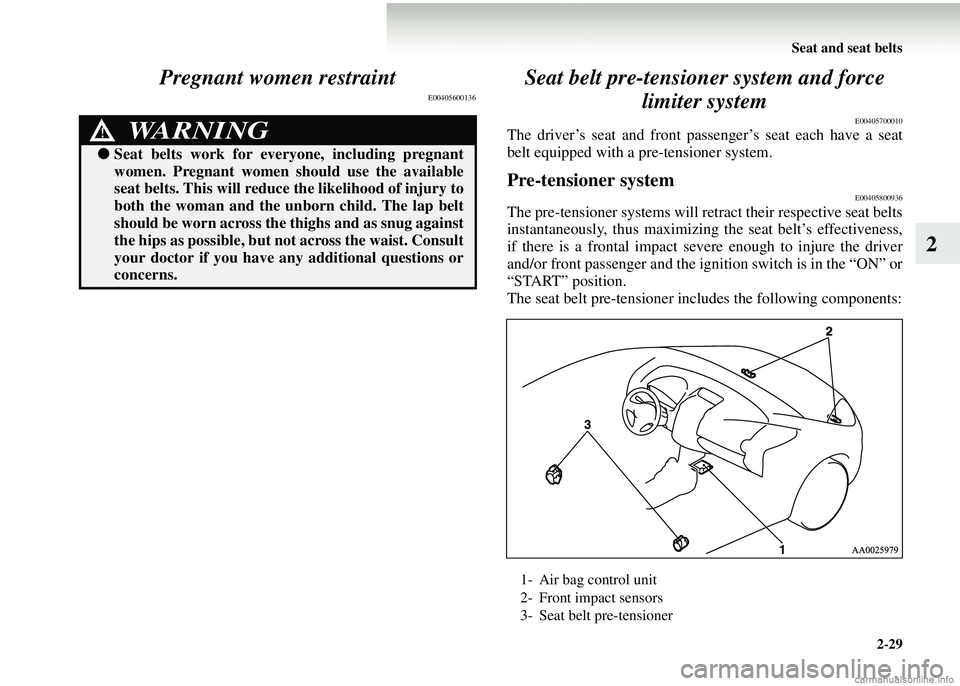
Seat and seat belts2-29
2
Pregnant women restraint
E00405600136
Seat belt pre-tensioner system and force
limiter system
E00405700010
The driver’s seat and front passenger’s seat each have a seat
belt equipped with a pre-tensioner system.
Pre-tensioner systemE00405800936
The pre-tensioner systems will retract their respective seat belts
instantaneously, thus maximizing the seat belt’s effectiveness,
if there is a frontal impact severe enough to injure the driver
and/or front passenger and the ignition switch is in the “ON” or
“START” position.
The seat belt pre-tensioner incl udes the following components:
WARNING!
●Seat belts work for everyone, including pregnant
women. Pregnant women should use the available
seat belts. This will reduce the likelihood of injury to
both the woman and the unborn child. The lap belt
should be worn across the thighs and as snug against
the hips as possible, but not across the waist. Consult
your doctor if you have any additional questions or
concerns.
1- Air bag control unit
2- Front impact sensors
3- Seat belt pre-tensioner
Page 100 of 450
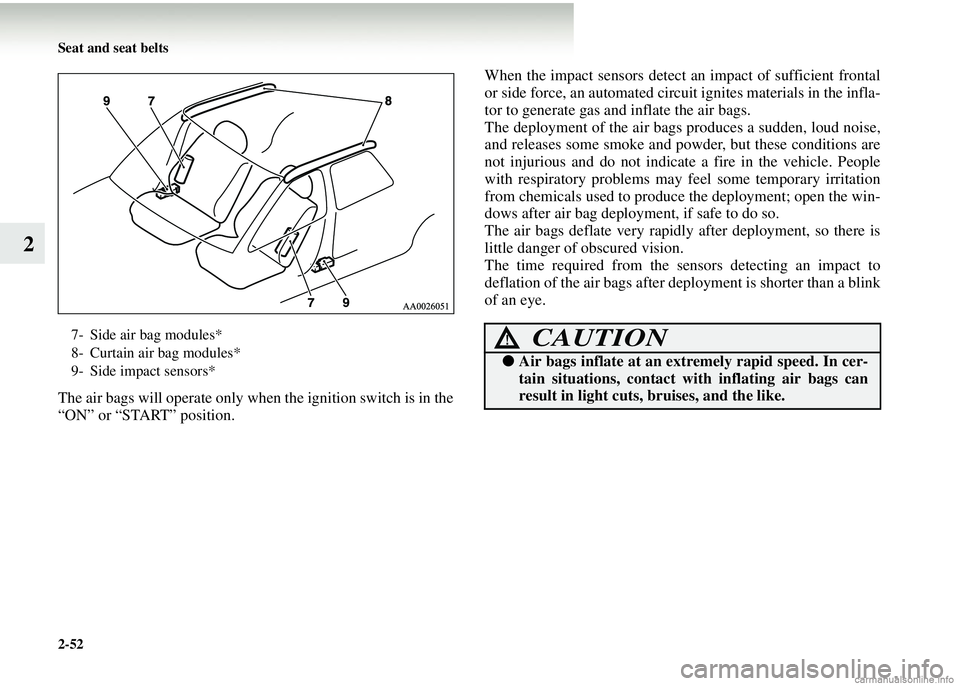
2-52 Seat and seat belts
2
The air bags will operate only when the ignition switch is in the
“ON” or “START” position.When the impact sensors detect
an impact of sufficient frontal
or side force, an automated circuit ignites materials in the infla-
tor to generate gas and inflate the air bags.
The deployment of the air bags produces a sudden, loud noise,
and releases some smoke and powder, but these conditions are
not injurious and do not indicate a fire in the vehicle. People
with respiratory problems may feel some temporary irritation
from chemicals used to produce the deployment; open the win-
dows after air bag deployment, if safe to do so.
The air bags deflate very rapidl y after deployment, so there is
little danger of obscured vision.
The time required from the sensors detecting an impact to
deflation of the air bags after deployment is shorter than a blink
of an eye.
7- Side air bag modules*
8- Curtain air bag modules*
9- Side impact sensors*CAUTION!
● Air bags inflate at an ex tremely rapid speed. In cer-
tain situations, contact with inflating air bags can
result in light cuts, bruises, and the like.
Page 107 of 450
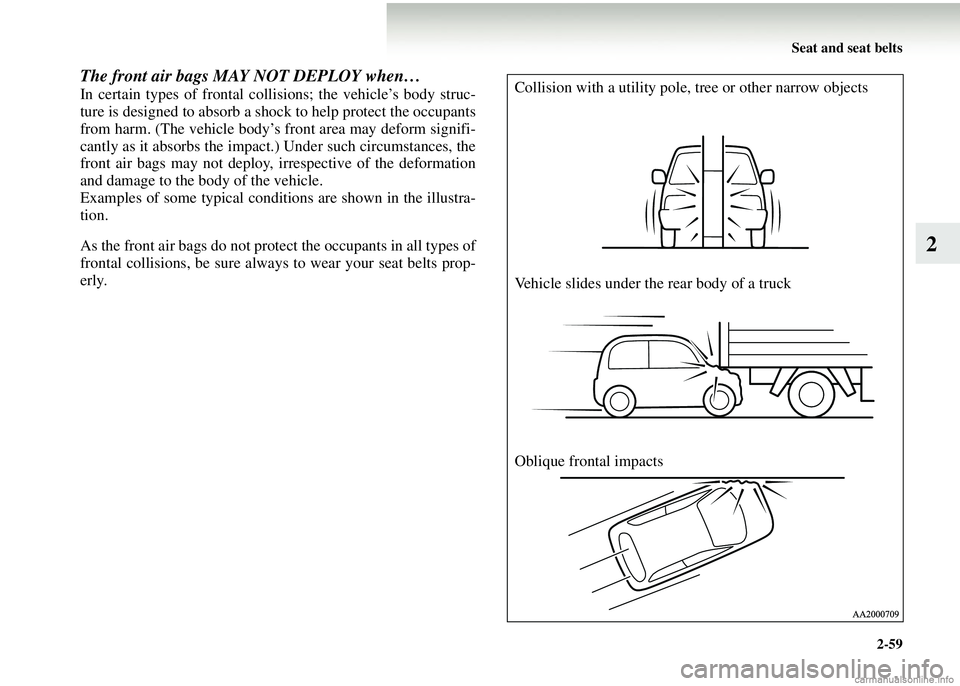
Seat and seat belts2-59
2
The front air bags MAY NOT DEPLOY when…
In certain types of frontal collisions; the vehicle’s body struc-
ture is designed to absorb a shock to help protect the occupants
from harm. (The vehicle body’s front area may deform signifi-
cantly as it absorbs the impact.) Under such circumstances, the
front air bags may not deploy, irrespective of the deformation
and damage to the body of the vehicle.
Examples of some typical conditions are shown in the illustra-
tion.
As the front air bags do not prot ect the occupants in all types of
frontal collisions, be sure always to wear your seat belts prop-
erly.Collision with a utility pole, tree or other narrow objects
Vehicle slides under the rear body of a truck
Oblique frontal impacts
Page 113 of 450
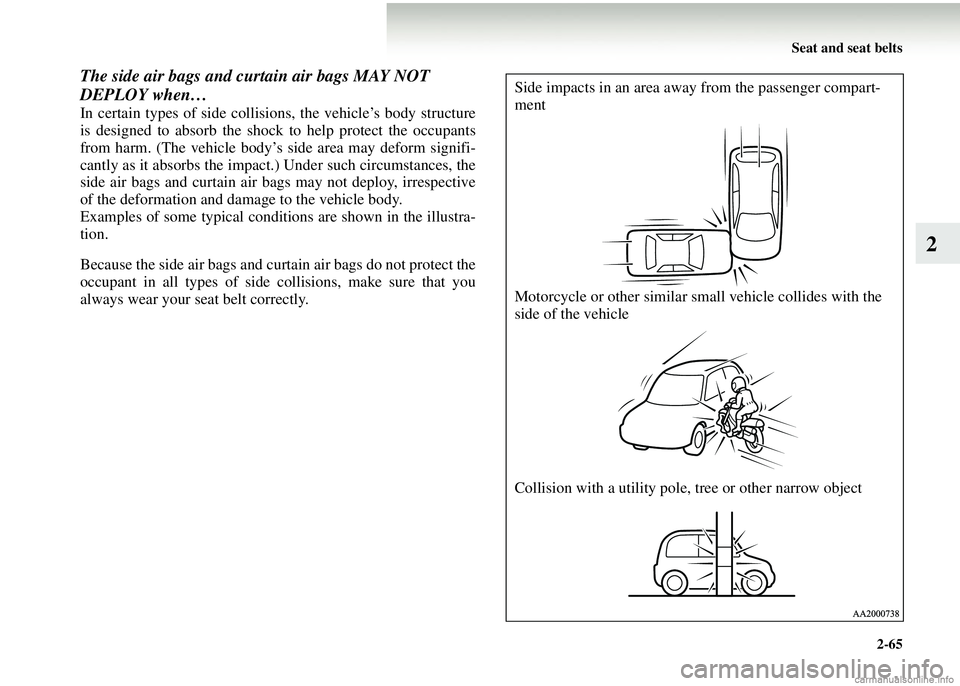
Seat and seat belts2-65
2
The side air bags and curtain air bags MAY NOT
DEPLOY when…
In certain types of side collisions, the vehicle’s body structure
is designed to absorb the shock to help protect the occupants
from harm. (The vehicle body’s side area may deform signifi-
cantly as it absorbs the impact.) Under such circumstances, the
side air bags and curtain air bags may not deploy, irrespective
of the deformation and damage to the vehicle body.
Examples of some typical conditions are shown in the illustra-
tion.
Because the side air bags and curtain air bags do not protect the
occupant in all types of side collisions, make sure that you
always wear your seat belt correctly.
Side impacts in an area aw ay from the passenger compart-
ment
Motorcycle or other similar sm all vehicle collides with the
side of the vehicle
Collision with a utility pole, tree or other narrow object